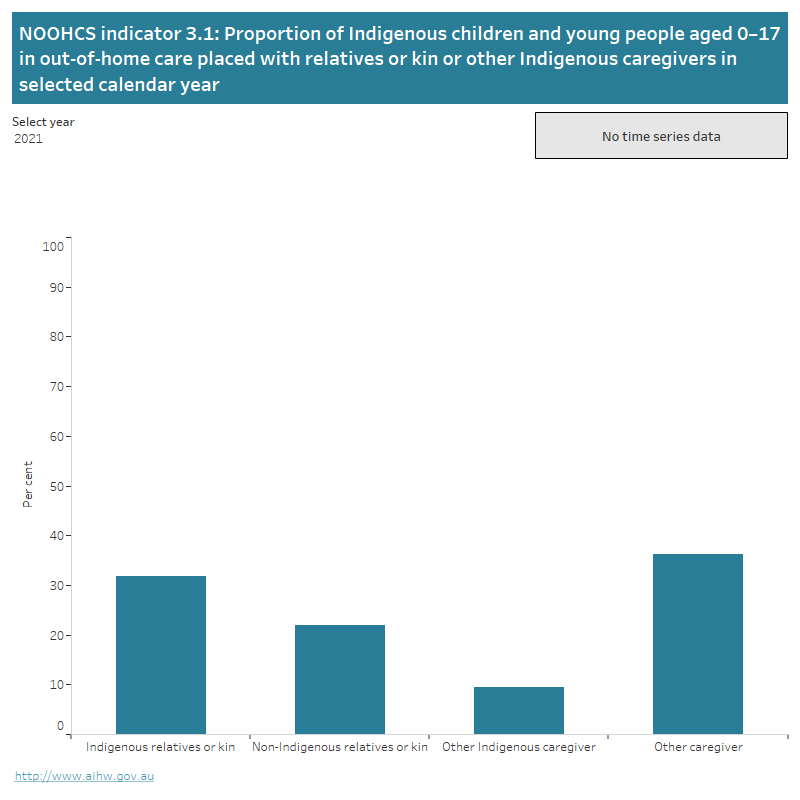3.1 Placement of Indigenous children
This indicator measures the same outcome as NFPAC Indicator 5.2 and therefore both indicators report the same numbers.
Care should be taken when interpreting the time series for this indicator, as it has been affected by the implementation of the national definition of out-of-home care.
As of 2019, all states and territories have adopted a nationally consistent definition of out-of-home care which excludes children on third-party parental responsibility orders, children on immigration orders, young people aged 18 and over, and children in pre-adoptive placements from counts of children in out-of-home care.
Out-of-home care data from the 2018–19 reporting period onwards are based on this nationally agreed definition and, where possible, back cast to 2016–17. These should not be compared with data for previous years or previously published out-of-home care data.
For more information on the national definition of out-of-home care, see Child protection Australia 2018–19.
Aboriginal and Torres Strait Islander children and young people benefit when they are able to maintain fundamental links to family, community, land and culture. The Aboriginal and Torres Strait Islander Child Placement Principle is a framework designed to embed in policy and practice a recognition of the value of these links to children in care. The principle specifies a hierarchy of preferred placement options for Aboriginal and/or Torres Strait Islander children who are unable to live with their families as follows:
- With Aboriginal and Torres Strait Islander or non-Indigenous relatives or extended family members (kin),
- With Aboriginal and Torres Strait Islander members of the child’s community; or
- With Aboriginal and Torres Strait Islander family-based carers.
The three options above are preferred placement types. If these preferred options are not available, as a last resort, the child may be placed in:
- Another care arrangement (such as with a non-Indigenous carer or in a residential setting) (SNAICC 2017).
This placement hierarchy is just one of many considerations taken into account when making decisions for placement of Aboriginal and Torres Strait Islander children. The Aboriginal and Torres Strait Islander Child Placement Principle and the placement hierarchy have been endorsed by all states and territories in Australia.
Trend data: For all indicator displays, the yearly trend is limited to indicators with 3 or more years (including the current year) of comparable time series data. To see the trend click on “Yearly Trend” button on the display. Where 3 or more years of comparable data including the most recent year is not available, a “No time series data” message is shown on the display.
The bar graph shows the proportion of Indigenous children and young people aged 0–17 in out-of-home care at 30 June placed with relatives or kin, non-Indigenous relatives or kin, other Indigenous caregivers or other caregivers. Data can be selected by year from 2010 to 2021.

Source: AIHW Child Protection Collection
See the supplementary data tables for further information and footnotes about these data.
For further information on placement of Indigenous children see The Aboriginal and Torres Strait Islander Child Placement Principle Indicators 2018-19: measuring progress.
References
SNAICC – National Voice for our Children. Understanding and applying the Aboriginal and Torres Strait Islander Child Placement Principle: a resource for legislation, policy, and program development. Melbourne: SNAICC. Accessed 16 June 2020.
Indicator technical specifications
The information below provides technical specifications for the summary indicator data presented in the quick reference guide.
| Definition | Data source | |
|---|---|---|
| Numerator |
Number of Indigenous children aged 0-17 years placed with relatives/kin or other Indigenous caregivers at 30 June |
AIHW National Child Protection Data Collection |
| Denominator | Number of Indigenous children aged 0-17 years in out-of-home care at 30 June | AIHW National Child Protection Data Collection |
Explanatory notes
Where Indigenous children are unable to live with their parents, culturally appropriate responses for their care and protection are needed. The Aboriginal and Torres Strait Islander Child Placement Principle outlines a preference for the placement of Aboriginal and Torres Strait Islander children with other Aboriginal and Torres Strait Islander people when they are placed outside their family. All jurisdictions have adopted this principle in legislation and policy. The principle outlines the following order of preference for the placement of Indigenous children: with the child’s extended family; within the child's Indigenous community; and with other Indigenous people.


